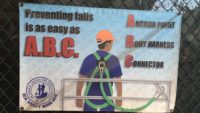The nation's largest specialty contractor is in the midst of a safety turnaround that it says is driving down fatalities and severe injuries.
Houston-based Quanta Services, which performs some of the most hazardous energy sector work involving pipelines and transmission infrastructure, has customized parts of a package of ideas known as '"New View" safety or Safety 2.0—the buzzier nicknames attached to optimizing human and organizational performance, or HOP.
Instead of preventing safety incidents and events, the emphasis is building capacity for them to happen safely.
Quanta Services operating units have cumulatively recorded a 29% year to year decrease in life-threatening, life-altering or fatal accidents, says Matthew C. Compher, the company's safety, environment and quality vice president.
Safety scientists have long perceived a difference between smaller and more severe breakdowns. Although Quanta and other contractors have been able to lower total recordable injury rates over the years using their existing safety programs, severe and fatal accidents have not declined at the same rate, and have actually risen in some cases.
Smaller construction employers, as well as some oil and gas companies and hospitals, have been using HOP or parts of it for years. But "there was nothing we could buy that we thought would work so we took all those lessons learned and created our own program," Compher says.
After his research of what HOP ideas entailed—no punishment for errors, streamlined safety rules and constant learning from mistakes about how to limit the peril when an error or accident does occur—Compher tailored the ideas to Quanta's needs. In late 2019, the company's corporate website debuted new pages headlined with the words "The Capacity Model"—a key concept that describes the ability to absorb and avoid severe injury even when mistakes are made.
As a final symbolic expression of a more individualized, bottom-up approach to working safely, Compher says he changed the way Quanta Services treats its safety manual in early 2021.
"We still have a manual and it is important, but that ownership has to be at a local, regional or operating unit level," he explains. "We can’t sit in Houston and write a rule that makes sense to every jurisdiction, and this allowed us to focus on our philosophy and direction for all of Quanta."
The impetus to continue the program remains clear. With 45,000 employees and close to $13 billion in 2021 revenue, Quanta Services is one of the largest direct employers in construction. It is the top-ranked firm on ENR's Top 600 Specialty Contractors list. In the past two years, the contractor has had a few fatal accidents involving electrocution and truck driving, according to public records reviewed by ENR.
"We're not perfect and we still experience significant events, just at a much lower frequency than before integrating the Capacity Model program," Compher says.
Other construction employers have had much longer experience with HOP safety and continue to use it. Electrical and electronics contractor M.C. Dean has used it since 2010, says John Bennett, senior vice president of safety, while Monarch Construction Co., a Cincinnati-based general contractor, has been using HOP ideas for about five years, says Eric Buschard, the company's safety director.
Errors Are Inevitable
The HOP approach assumes workers will make errors and that emphasis should be on the work environment and processes to prevent severe injuries.
The system is a departure from the popular behavioral safety programs practiced by many employers that HOP advocates believe concentrate too much on the individual worker who makes a mistake. That often leads to blame that discourages honest evaluation of what occurred.
In addition to non-punitive incident reporting and discussions, HOP advocates say they try to avoid concentrating on low-injury rates or on what some see as an obsession with zero injuries or incidents.
Prior to his adoption of some HOP ideas, Compher says, "my whole career consisted of traditional TRIR (Total Recordable Injury Rates), hand injuries, and slips and falls, all of which have an effect. But the things that hurt us are not things that are killing us and we need to treat them differently."
A lot of the effort is in identifying the STKY, or "S**T that kills you," a favorite HOP phrase. The extensive writings by HOP theorists such as Todd Conklin, or his like-minded co-author, Australia-based Sidney Dekker, are not distributed as part of the Capacity Model program.
Cited by National Safety Council
Earlier this year, the National Safety Council deemed Quanta Services a finalist in the innovation category of its annual safety program.
So far, according to the council, firm employees are showing a greater awareness of serious hazards and a shift in organizational tone toward improving and holding healthy dialogues. There's also an "increased appetite among employees for learning about the context of events," the safety group wrote.
What about clients who for years have based their estimates of a contractor's safety performance solely on compliance, injury rates and punishment of those who violate rules, and who don't necessarily buy in to the "new" safety ideas?
"We talk to them about our philosophy, how it's making a difference and influence them as much as we can," says Compher. "But at the end of the day we own our safety and we are moving forward.”





Post a comment to this article
Report Abusive Comment